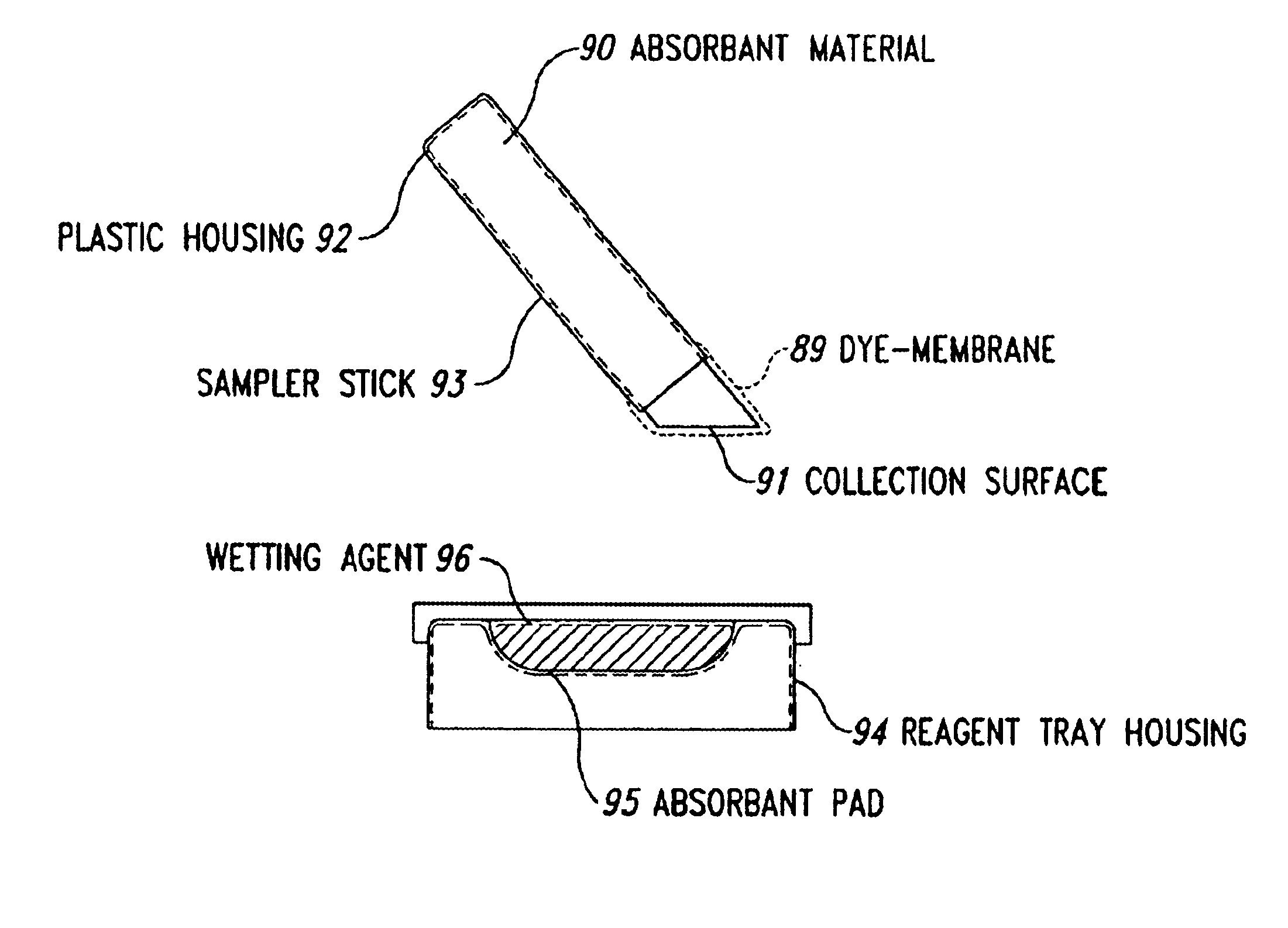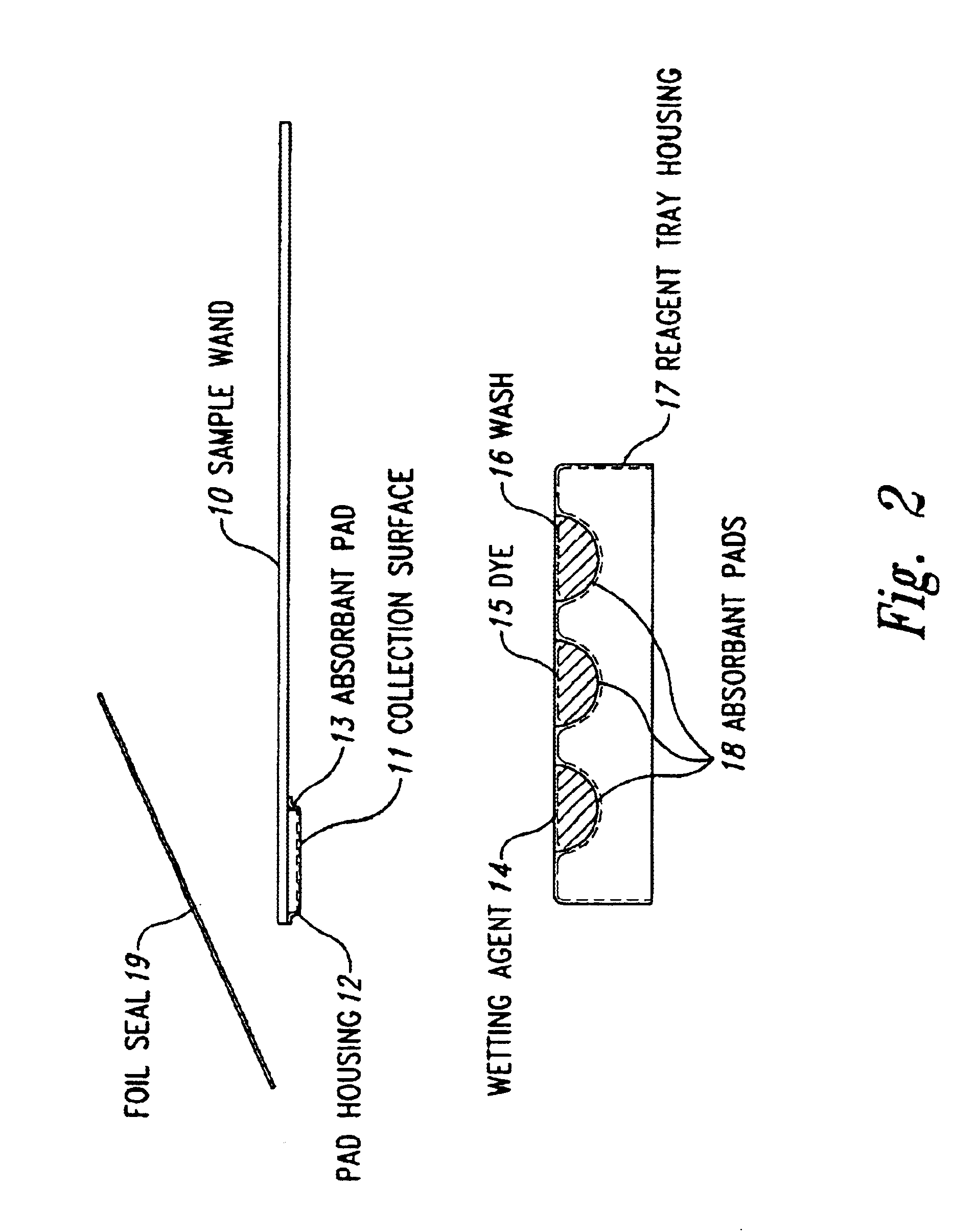Self-contained devices for detecting biological contaminants
a technology of self-contained devices and biological contaminants, which is applied in the direction of laboratory glassware, analysis material containers, instruments, etc., can solve the problems of contaminant finding on equipment or other surfaces, requiring expensive and complicated equipment, and contaminant testing may be time-consuming and labor-intensiv
- Summary
- Abstract
- Description
- Claims
- Application Information
AI Technical Summary
Benefits of technology
Problems solved by technology
Method used
Image
Examples
example 1
Exemplary devices were constructed as generally described in FIG. 2 and used with a precipitating dye (Ponceau 5) and a frequency shift dye (a colloidal Coomassie Blue dye, Gelcode®) and used to test food surfaces soiled with milk, cheese, roast beef, turkey, or tomato. The surfaces were also tested with a food industry-accepted means of measuring surface contamination based on ATP detection (LIGHTNING, produced by IDEXX Laboratories, Westbrook, Me.)(used according to manufacturer's instructions) as well as the protein detection devices described for this invention. As indicated, two different embodiments of the present invention were used. One with Ponceau-S as the protein-binding dye, and one with Gelcode®—a colloidal Coomassie blue dye.
Stainless steel surfaces were smeared with the indicated food materials. For each test, a sample was obtained from the surface by swabbing with the moistened sampler collection surface of a sampler from the particular device. “Dirty” indicates that...
example 2
An exemplary device constructed as generally described in FIG. 6 and containing 2 ml Pierce Gelcode® dye was used in a test to determine detection sensitivity of the device. Presence of protein was detected using qualitative visual reading and by reading the optical density (OD) at 595 nm, with the reported OD being the mean of two readings.
Bovine serum albumin (BSA) at various concentrations was dried on clean 4″×4′ stainless steel coupons. For each sample tested, the pre-moistened swab portion of a device was swiped over the coupon surface with firm pressure to collect the sample. The swab was inserted into the housing, and the dye reservoir bulb snapped to the side to deliver the dye into the lower read chamber. A visual interpretation is then made, followed by transfer from the read chamber to a disposable cuvette for reading at 595 nm. The results are shown in Table 2.
SampleO.D.Visual InterpretationNegative control (PBS)0.0006NegativeBSA, 5 μg / test3.3800+ + + +BSA, 50 μg / test1....
example 3
An exemplary device as in Example 2 was used in a comparison test of biological contamination with the Konica Hygiene Monitoring Kit. The Konica kit was utilized according to manufacturer's instructions with reading after 10 minutes at room temperature. The exemplary device was utilized as follows.
Various different sources of protein were dried upon clean 4˜×4˜ stainless steel coupons, which had been marked to divide each coupon into two equal parts. The exemplary device was used to collect the sample from the left side of the coupon surface. Following the Konica kit procedure, the corresponding right side of the coupon was sampled with the Konica swab. Visual interpretation for the exemplary device was made immediately upon activation. The Konica test was read at 10 minutes according to kit instructions. The stainless steel coupons were then washed with a mild detergent (Palmolive®) and water, and after drying, each side of the coupon was retested to detect any remaining contaminat...
PUM
 Login to View More
Login to View More Abstract
Description
Claims
Application Information
 Login to View More
Login to View More - R&D
- Intellectual Property
- Life Sciences
- Materials
- Tech Scout
- Unparalleled Data Quality
- Higher Quality Content
- 60% Fewer Hallucinations
Browse by: Latest US Patents, China's latest patents, Technical Efficacy Thesaurus, Application Domain, Technology Topic, Popular Technical Reports.
© 2025 PatSnap. All rights reserved.Legal|Privacy policy|Modern Slavery Act Transparency Statement|Sitemap|About US| Contact US: help@patsnap.com



